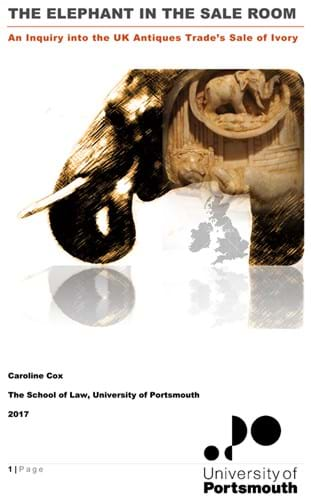
While not advocating an outright ban, The Elephant in the Saleroom: An Inquiry into the UK Antiques Trade’s Sale of Ivory, by the University of Portsmouth, says the UK needs “enforceable and effective regulations that distinguish the legal ivory trade from the illegal trade in ivory”.
However the report, authored by Caroline Cox and based on market research conducted in 2016, was based on responses from a small sample of dealers and auctioneers which has raised questions over the reliability of its conclusions.
Rebecca Davies, chief executive of LAPADA: “We are disappointed with the final report from Portsmouth which appears to be statistically insignificant and draws conclusions from limited anecdotal evidence.”
Marco Forgione, BADA's chief executive, echoed this, citing "concerns about the methodology and conclusions drawn from such a limited sample of responses".
The report itself declares: “Admittedly, with such a small sample it is difficult to make strong assumptions about the universe of the antiques trade.”
Cox told ATG: "We have to work with what we've got. The survey was widely advertised and we worked with the stakeholders and trade associations to help gain respondents. The whole population of the trade could have taken part."
Nonetheless, the report does come to conclusions, based on 80 respondents to an online questionnaire and 12 one-to-one interviews with dealers and auctioneers (see ‘Methodology,’ below), findings that will make occasional uncomfortable reading for the antiques trade.
Report rationale
The report seeks to highlight the issues surrounding the current ivory legislation and in particular a reliance on what it called “an educated and conscientious antiques trade” to accurately determine that any item was ‘worked’ before 1947.
The report says:
- Almost all respondents relied primarily on ‘knowledge and experience’ (colour, the quality of the carving, etc) in assessing ivory that came to them for sale
- Only one of the respondents reported using scientific testing as a means of assessing the age of an ivory object.
Cox said: “The difficulty for policy makers, in the event that they should endorse a legal antique trade in ivory, is the creation of workable, enforceable and effective regulations that distinguish the legal ivory trade from the illegal trade in ivory.”
Report recommendations
- Law makers should consider introducing a passport-type document for higher value ivory items
- Law makers should provide clear guidance as to what ‘documentary evidence’ may mean in the event of law changes
- Associations such as BADA and LAPADA need to take a lead with regards to education and make easily available a ‘Best Practice Guide’ regarding the law and the sale of ivory.
Forgione stressed that BADA was "actively working with Government to ensure that the UK remains at the forefront of the battle to stamp out the illegal trade in poached ivory".
Evidence of an illegal trade in the UK was anecdotal. During one-to-one interviews “some participants stated their belief that whilst they were selling ivory within the bounds of the regulations they knew of (or had witnessed) dealers who were not”.
Public education
The report said that while trade bodies were adept at providing advice to their members, this did not extend to the education of the wider antiques community or the public.
“Strikingly, none of the organisations that we researched had any specific advice on their front facing websites regarding the laws and regulations on the sale of ivory,” said Cox.
DEFRA was also found to be an imperfect source of information. Interviewees said that they found DEFRA’s guidance to be unclear and unhelpful stating that “the explanations and terminology they use is not clear” and that “the guidance is flimsy”.
Only eight dealers (25%) and four auctioneers (44%) said they relied on DEFRA for CITES guidance and updates. DEFRA’s website was described as being “confusing” and “unhelpful”.
Methodology
The survey was conducted via online questionnaire (‘quantitative’ research) and in-depth interviews (‘qualitative' research).
Responses to the online survey totalled 80, while 12 dealers and auctioneers were interviewed one-to-one, conducted in the first half of 2016.
The authors themselves refer to the study’s low response rate, which Cox said “highlighted the difficulties in obtaining information from the antiques trade about the nature of their practices regarding the sale of ivory”.
The report said the low response rate “illustrates the methodological hurdles we can find when aiming to uncover information relating to the sale of ivory from the key stakeholders themselves (even using anonymous survey tools)”.
The majority (61%) of respondents described themselves as ‘dealers’, followed by auctioneers (24%) with the ivory objects they sold acquired from a variety of sources, including house clearances, private sales, fairs, auctions, shops and car boot sales.
Approximately half of respondents were members of a trade association.





